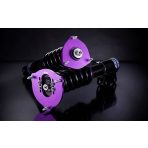D2 Racing Suspension Kits
D2 Racing Suspension Kits cover daily street, track-day sport and dedicated drift use with threaded coilover designs, 36-step damping and independent ride-height adjustment to preserve usable travel. Choose by application: D2 Racing Sport Coilover Kits – By Make for fast road and circuit work, or D2 Racing Drift Coilover Kits – By Make for sideways-focused valving and geometry control.
Overview & Main Product Lines
D2 Racing Suspension Kits are designed to provide a tunable chassis platform matched to each car and use case—whether you need compliant Street behaviour, sharp Sport response or drift-oriented Drift valving. All ranges share core features such as threaded coilover architecture, independent ride-height adjustment and multi-step damping, so you can fine-tune stance, balance and response. Brand- and model-specific pages make it easy to find the exact kit that fits your car and intended use.
Technical Basics
Every D2 kit uses a threaded damper body, carefully matched linear or progressive springs, an adjustable lower mount and a vehicle-specific top mount. Ride height is always set at the lower mount, so preload and effective spring travel are not sacrificed for stance. Sport and Drift ranges typically offer 36-step damping, allowing detailed control of compression bite and rebound support, while Street kits prioritise comfort with broader, more forgiving valving but still retain a useful adjustment window.
Construction usually combines high-strength damper housings, SAE9254 spring steel and 6061-T6 aluminium brackets with corrosion-resistant finishes. Many applications allow you to choose between rubber upper mounts—ideal for low NVH in daily use—and rigid pillowball top mounts, which maximise steering precision and feedback. Dedicated drift coverage is organised in D2 Racing Drift Coilover Kits – By Make, while track-day and fast-road options are shown under D2 Racing Sport Coilover Kits – By Make.
Selection Criteria
Start by defining your primary use: commuting and touring, fast B-road and track-day driving, or dedicated drift. For daily-driven cars the Street-oriented kits deliver the best compromise, with softer valving and comfort-biased settings; for laptimes and time-attack a Sport kit offers firmer support and flatter cornering; for sideways builds, the Drift range provides fast weight transfer, long-angle stability and predictable return. The three families are summarised across the brand-specific collections, and the D2 Racing Street Suspension Kits overview covers comfort-focused options in more detail.
Consider realistic ride-height targets: for mixed road use, a drop of roughly 30–50 mm often hits the sweet spot between lowering the centre of gravity and preserving geometry. Going much lower quickly shortens travel, worsens arm angles and increases the risk of bottoming or tyre-to-arch contact. Also factor in wheel and tyre sizing (width, profile, offset), alignment goals and whether you need additional negative camber (via camber plates, eccentric bolts or adjustable arms)—all of which influence which D2 range best suits your project.
Installation & Maintenance
Installation quality has a direct impact on reliability and safety. Clean all mating surfaces thoroughly, apply copper grease or dedicated anti-seize to threads and always set height via the lower mount, not by over-compressing the spring—this avoids excessive preload and reduces the chance of binding. Torque all hardware to OE specifications, then perform a full wheel alignment (toe/camber/caster) once the car has settled. After the first few hundred kilometres, and after any hard track or drift session, re-torque critical fasteners and visually inspect mounts and fasteners.
If your build includes extended steering angle, significantly wider wheels or heavily altered suspension geometry, regular clearance checks around arches, anti-roll links, brake lines and chassis points are essential. Winter and salted-road use calls for frequent rinsing and thread protection to extend service life: keeping the damper body threads clean and lightly protected makes future height and corner-weight adjustments far easier.
FAQ
What’s the difference between D2 Street, Sport and Drift kits?
Street kits focus on comfort and daily usability with softer valving, Sport kits aim at flat, grippy handling for fast road and track days, and Drift kits use valving tuned for rapid weight transfer, long-angle stability and controlled return in slides.
How low should I go on a road-driven car?
For most builds, a 30–50 mm drop is a practical starting point. Lower than that often compromises suspension geometry, reduces spring travel and increases bottoming or rubbing risk, especially on poor road surfaces.
Do I really need a wheel alignment after fitting a D2 kit?
Yes. Any change in ride height and camber alters toe, camber and caster. Without a proper alignment the car may feel nervous, tyres can wear rapidly and it becomes harder to drive consistently at the limit.
Are pillowball top mounts suitable for daily use?
Pillowball mounts are usable on the street but increase noise and vibration. For mixed use, start with moderate damping settings, a sensible ride height and good tyres, then stiffen and lower gradually if you move towards more track- or drift-focused driving.
What should I check if I hear clunks at full steering lock?
Common causes are excessive preload, spring binding or interference between angle-kit components, arms, brake lines or bodywork. Inspect clearances carefully, verify torque settings, adjust ride height if necessary and revert to a conservative baseline before re-tuning.




